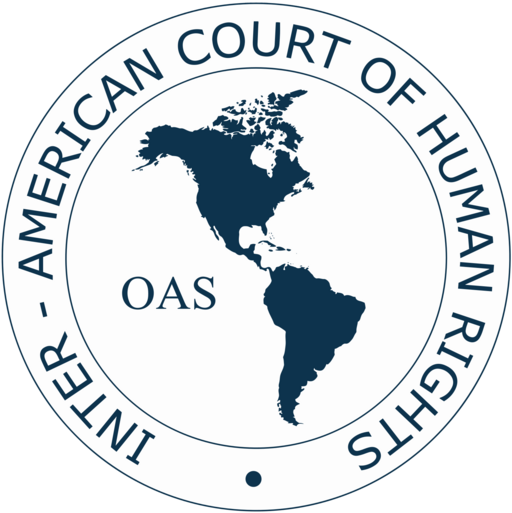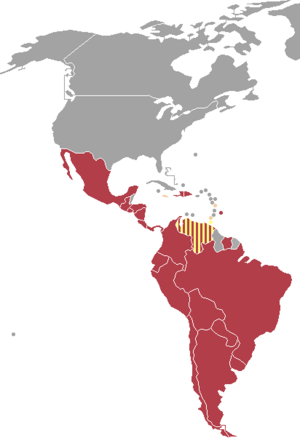Inter-American Court of Human Rights facts for kids
Quick facts for kids Inter-American Court of Human Rights |
|
|---|---|
| Corte Interamericana de Derechos Humanos (Spanish) Corte Interamericana de Direitos Humanos (Portuguese) Cour interaméricaine des droits de l'homme (French) |
|
 |
|
| Established | 22 May 1979 |
| Location | |
| Authorized by | American Convention on Human Rights Statute of the Inter-American Court of Human Rights |
| Judge term length | Six years |
| Number of positions | Seven |
| Website | https://www.corteidh.or.cr/index.cfm?lang=en |
| President | |
| Currently | Nancy Hernández López |
| Since | 2024 |
| Vice-President | |
| Currently | Rodrigo Mudrovitsch |
| Since | 2024 |
The Inter-American Court of Human Rights (often called the I/A Court H.R.) is an important international court. It is located in San José, Costa Rica. This court works with the Inter-American Commission on Human Rights to protect and promote human rights. Both were created by the American Convention on Human Rights. This is a special agreement signed by many countries in the Organization of American States (OAS).
The Inter-American Court helps make sure that basic rights and freedoms are respected. It has power in about 20 countries in the Americas. Most of these are in Latin America. The court looks into complaints about governments breaking human rights rules. It also gives advice on how to understand certain laws.
Contents
What the Court Does
The Organization of American States (OAS) started this Court in 1979. Its job is to make sure the rules of the American Convention on Human Rights are followed. It also helps explain these rules. The Court has two main jobs: deciding cases and giving advice.
Deciding Cases
When the Court decides cases, it looks at specific complaints. These complaints are usually about a country breaking human rights rules. For the Court to hear a case, the country must have agreed to its power.
Many countries have agreed to the Court's power for all cases. These include Argentina, Brazil, Chile, Colombia, Costa Rica, Ecuador, Mexico, and Peru. Some countries, like Trinidad and Tobago and Venezuela, later left this agreement. A country can also agree to the Court's power for just one specific case.
People cannot take cases directly to this Court. First, they must complain to the Inter-American Commission on Human Rights.
- If the Commission agrees the complaint is valid, it usually tells the country what to do to fix the problem.
- The case only goes to the Court if the country does not follow these suggestions.
- Or, the Commission might send a case to the Court if it is very important or has a special legal question.
- So, going to the Court is often a last step, after other ways to solve the problem have not worked.
Cases before the Court have two parts: a written part and an oral part.
Written Part of a Case
In the written part, the complaint is officially filed. This document explains what happened, who is involved, and what evidence will be used. It also states what the victims are asking for. If the Court's secretary accepts the complaint, everyone involved is told. This includes the judges, the country, the victims, and other OAS members.
The parties in the case have 30 days to raise any initial objections to the complaint. The Court might hold a meeting to discuss these objections. Or, it might discuss them along with the main points of the case later.
The country accused of the human rights violation has 60 days to respond in writing. They must say if they agree or disagree with the facts and claims. After this, parties can ask to submit more written information before the oral part begins.
Oral Part of a Case
The Court's president sets the date for the oral part of the case. At least five judges must be present for the Court to hear the case.
During this part, judges can ask questions to anyone appearing before them. This includes witnesses and experts. Representatives from the Commission, the country, or the victims can also ask questions. The president decides if questions are relevant.
Court's Decision
After hearing everyone and looking at all the evidence, the Court makes its decision. The judges discuss the case in private. Once the decision is made, everyone involved is told. If the decision does not include how to fix the problem, the Court will decide on that later.
The Court can order different types of solutions. These can be money payments to victims or their families. But they can also be other things. For example, a country might have to:
- give free healthcare or education support.
- say sorry publicly for what happened.
- change its laws to prevent similar problems.
- build a memorial for victims.
For example, in a case from 2001 called Barrios Altos v. Peru, the Court ordered Peru to pay money to victims' families. It also told Peru to provide free healthcare and education. Peru also had to change some laws and apologize publicly. The Court also ordered Peru to build a memorial for the victims.
The Court's decisions are final. You cannot appeal them. However, parties can ask the Court to explain its decision within 90 days.
Giving Advice
The Court also gives advice. OAS groups and member countries can ask the Court to explain parts of the human rights agreement. The Court can also advise on a country's laws. It can say if these laws fit with the human rights agreement. This advisory power is for all OAS member countries, even those that have not fully agreed to the Court's power in cases. The Court's advice is published as "advisory opinions."
Countries Involved
The American Convention on Human Rights started in 1978. Most Latin American countries are members, except for Cuba. Some Caribbean countries are also members.
Some important leaders from Latin America who cared about fair laws include Simón Bolívar and Antonio José de Sucre.
- Trinidad and Tobago joined in 1991 but left in 1999.
- Peru tried to leave in 1999 under President Alberto Fujimori. But a new government reversed this decision in 2001.
- Venezuela left the agreement in 2013. However, in 2019, the opposition government said this withdrawal was not valid.
- The Dominican Republic said it was leaving in 2014. But the Court says this withdrawal was never legally completed. As of 2017, the Court still considered the Dominican Republic a member.
- The United States signed the agreement but never officially joined it.
How the Court is Made Up
The Court has seven judges. They must be people with high moral standards and a lot of knowledge about human rights law. These judges are chosen for six-year terms by the OAS General Assembly. They can be chosen again for another six-year term.
Judges are expected to act as individuals, not as representatives of their home country. They must be citizens of an OAS member country. However, they do not have to be from a country that has fully agreed to the Court's power. If a case involves a judge's home country, that judge cannot be part of the decision.
To become a judge, a person must be a citizen of an OAS member state. They must be a legal expert with "highest moral authority." This means they have never been convicted of a crime or removed from a public job. They also need strong knowledge of human rights law.
Judges are elected by the countries that are part of the human rights agreement. Each country can suggest up to three candidates. If they suggest three, at least one must be from a different country. The OAS Secretary General lists the candidates. The election is by secret vote, and judges are chosen based on who gets the most votes.
The first judges were elected on May 22, 1979. The new Court met for the first time on June 29, 1979, in Washington, D.C., United States.
Judges and Leaders
Current Judges
Recent Presidents of the Court
| Years | Country | Judge |
|---|---|---|
| 2020–2021 | Ricardo Pérez Manrique | |
| 2018–2019 | Eduardo Ferrer Mac-Gregor Poisot | |
| 2016–2017 | Roberto de Figueiredo Caldas | |
| 2014–2015 | Humberto Sierra Porto | |
| 2010–2013 | Diego García Sayán |
Important Cases Heard by the Court
The Court has heard many important cases. Here are a few examples:
| Case | Date | Ruling Link |
|---|---|---|
| Velásquez-Rodríguez v. Honduras | 29 July 1988 | [1] |
| Caracazo v. Venezuela | 11 November 1999 | [2] |
| "The Last Temptation of Christ" (Olmedo-Bustos et al.) v. Chile | 5 February 2001 | [3] |
| Barrios Altos v. Peru | 14 March 2001 | [4] |
| Myrna Mack Chang v. Guatemala | 25 November 2003 | [5] |
| Plan de Sánchez Massacre v. Guatemala | 29 April 2004 | [6] |
| Herrera-Ulloa v. Costa Rica | 2 July 2004 | [7] |
| Lori Berenson-Mejía v. Peru | 25 November 2004 | [8] |
| Moiwana Community v. Suriname | 15 June 2005 | [9] |
| "Mapiripán Massacre" v. Colombia | 15 September 2005 | [10] |
| Almonacid-Arellano et al v. Chile | 26 September 2006 | [11] |
| Gomes Lund et al. ("Guerrilha do Araguaia") v. Brazil | 24 November 2010 | [12] |
| Gelman v. Uruguay | 24 February 2011 | [13] |
| Atala Riffo and daughters v. Chile | 24 February 2012 | [14] |
| Marcel Granier and other (Radio Caracas Television) v. Venezuela | 22 June 2015 | [15] |
See also
- European Court of Human Rights, a similar court in Europe
- African Court on Human and Peoples' Rights, a similar court in Africa
- International Criminal Court


